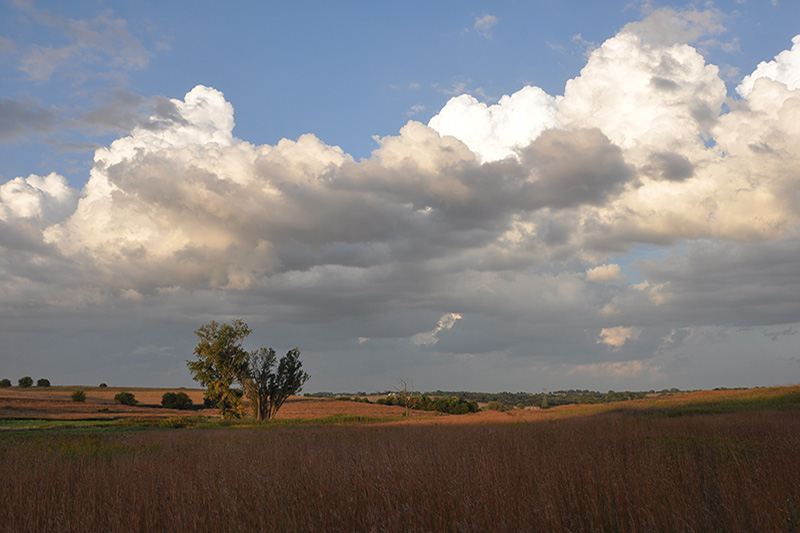"As I looked about me I felt that the grass was the country, as the water is the sea."- Willa Cather

Glacier Creek Preserve is a restored Tallgrass Prairie nature preserve used for research, teaching, and community engagement. It is among the largest of the early prairie restorations that were intended to restore tallgrass prairie, an ecosystem of which less than 1% remains. The 1856 survey of the area around Glacier Creek noted “There is but little timber, which is in the north part of the Township on the Big Papillion...” [this timber is well north of present Glacier Creek]. The Preserve has a diverse flora and fauna which has been maintained with prescribed burning since 1970. Typically, one-third of the Preserve undergoes burning each spring, adhering to a three-year fire return interval, believed to mirror the pre-settlement burn frequency of the tallgrass prairie in this area.
History in Brief: The land presently making up Glacier Creek Preserve was part of the area first homesteaded in 1880 by Hans and Christiana Nielsen from Denmark. Most likely this was the approximate year that the area was converted from prairie to cropland. Fast forwarding, in 1959, the 65 ha (160 acre) Glen Haven Farm was donated to the University of Nebraska at Omaha (then the Omaha University). In 1970, 57 ha (140 acres) of the farm were reseeded to five species of native tallgrass prairie grasses establishing Allwine Prairie Preserve. Between 2009 and 2019, purchase of surrounding cropland resulted in today’s 212 ha (525 acre) Glacier Creek Preserve, a preserve that encompasses the entire Glacier Creek drainage. Glacier Creek is a small, spring-fed creek that is part of the larger Missouri River drainage. It was recorded in the 1856 land survey field notes as: “Spring brook 4 links [0.8 m or 32 in] wide runs E.” Allwine Prairie, now the Allwine Prairie Tract, is at the core of today’s Preserve.
Map of Glacier Creek Preserve
Objective
The objective of Glacier Creek Preserve is to maintain an ecologically sustainable, landscape-level wildlife preserve focusing on tallgrass prairie and related ecosystems that will serve present and future generations both as a site for environmental research and education and as an important community resource for the appreciation of our historic prairie environment.
Description
Glacier Creek Preserve is a 212 ha (525 acre) restored tallgrass prairie preserve that is divided into four tracts: The Allwine Prairie Tract (the original preserve created from cropland in 1970), the Papio Tract, the Barbi Hayes Overlook, and the Bouteloua Tract. The Preserve situated northwest of Omaha in the rolling hills of eastern Nebraska. Embedded within the Preserve is the 57 ha (140 acres) Allwine Prairie Tract, a restored tallgrass prairie created in 1970. Large enough to sustain a diversity of functioning plant and animal communities, Glacier Creek Preserve incorporates an entire sub-watershed. This feature protects the preserve against effects of surrounding land use thus reinforcing its sustainability into the foreseeable future as a unique metropolitan area preserve available for education, research, and appreciation of our natural heritage.
The Barn at Glacier Creek
Essential to Preserve activities is The Barn at Glacier Creek (aka the Barn), the preserve's environmental research and education facility that provides classroom space, a field lab, restrooms, and a multi-functional space in the hayloft of the second floor that can accommodate over 50 individuals.
The Barn also houses the Preserve office, staffed by the Preserve Operations Administrator and the Land Management Specialist. The Barn, a 1900's era historic barn, was donated and moved from its original location on the Roy Johnson family farm to Glacier Creek Preserve in 2012 with the donation provided by the Roy Johnson Family Partnership and Barbi Hayes, a major owner of the partnership. Barbi Hayes also funded upgrading the Barn which includes geothermal heating and cooling, is fully ADA accessible, and has full wireless and port access to the internet. Use of the Barn is coordinated by Preserve Staff.
Other structures in the headquarters area include the Land Management Specialist’s house, a 1950's era double-garage storage structure, and a metal shed for Preserve vehicles.
Check out additional information about Glacier Creek Preserve by selecting from the main drop-down menus or clicking the links below.
- Our Vision
- Physical Environment
- Pre-K-12 / Higher Education
- Locations & Directions
- Preserve Development History
- General Public Access
- Preserve & Barn Hours
- Preserve Management & Restoration
- Visitor Use Policies
- The Barn at Glacier Creek
- Flora & Fauna at the Preserve
- Preserve Events
- Contact Us
- Prescribed Burning
- Self-guided Walk
- Volunteer Opportunities
- Volunteer for a Burn
- Research Guidelines & Permissions
- Donate
- Affiliated Preserve - T.L. Davis
- Research at Glacier Creek